StoryChief is a content marketing platform that streamlines content creation and distribution. Although it’s good, the platform also has shortcomings when it comes to its collaboration features and the depth of its analytics capabilities.
So, if you’re looking for the best StoryChief alternatives currently available, check out my tried-and-tested list below.
Why should you consider StoryChief alternatives?
StoryChief offers numerous features designed to make the content marketing and distribution process a breeze. Its standouts include a handy AI assistant useful for content ideation, research, and editing and a built-in SEO copywriting tool that scores your content and offers suggestions to maximize visibility on search engine results.
As for its drawbacks, the platform lacks real-time collaboration capabilities, which can significantly slow down the content creation and distribution process.
Additionally, the platform’s analytics tool allows you to track content performance across multiple networks. But StoryChief doesn’t include any network-specific metrics, like your LinkedIn audience’s seniority levels or your TikTok hashtag performance. It also doesn’t give you the insights necessary to adjust your approach on specific networks.
Planning
StoryChief includes an intuitive calendar that allows you to schedule numerous content types — from social media posts to newsletters, blogs, webinars, and more. You can easily filter between scheduled content by post type, approval status, and channel, for instance.
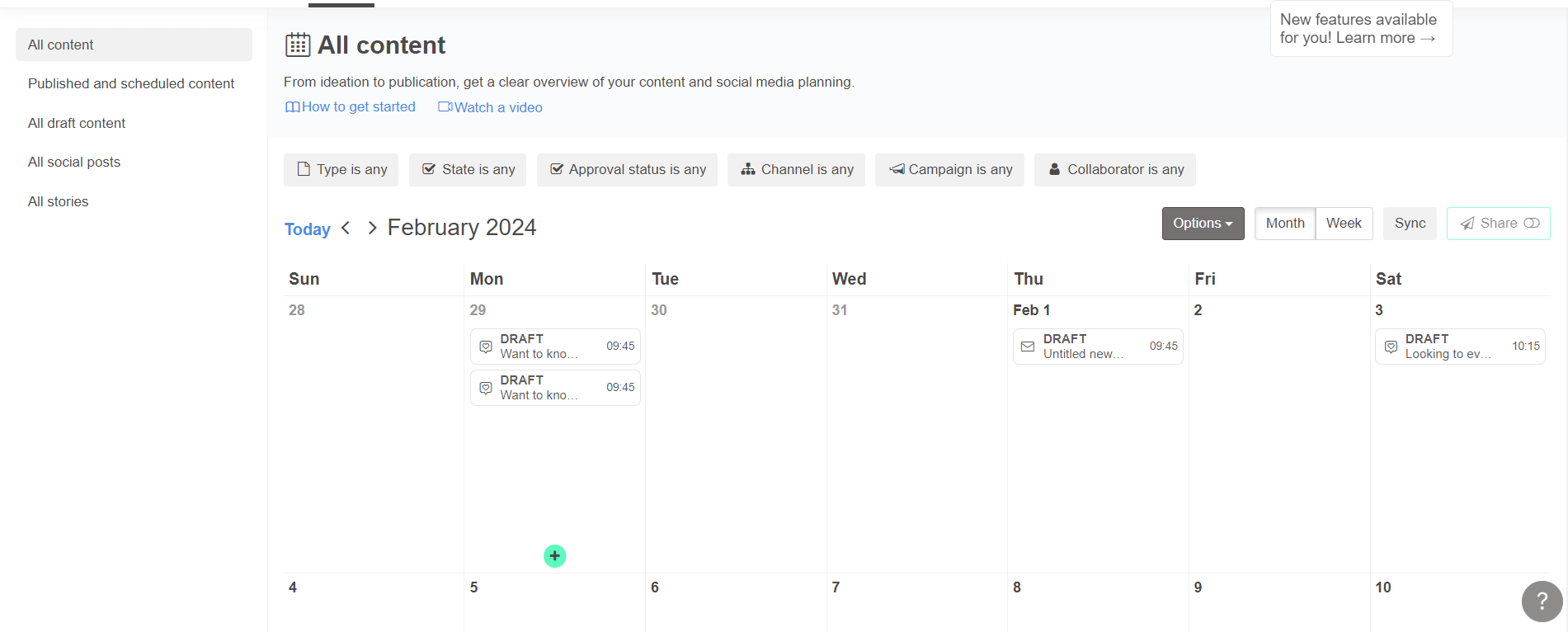

I found the option to create editorial briefs within the calendar particularly convenient — you can leave instructions, attach files, and specify the word count under each scheduled post.
However, I noticed that there’s no option to quickly reschedule posts once you added them to the calendar. You’ll need to click on the post, unscheduled it, and then reschedule it for a later date, which takes more clicks than necessary.
Collaboration
StoryChief allows you to invite both internal and external collaborators to the platform and assign specific roles, like guest writer, publisher, or internal writer, for instance.
You can leave feedback through comments on each post directly within the calendar, with the option to make comments visible only to internal collaborators — handy for working behind the scenes.
There’s also a separate tab where you can request edits. You can tag specific team members and leave notes about what needs to be changed.
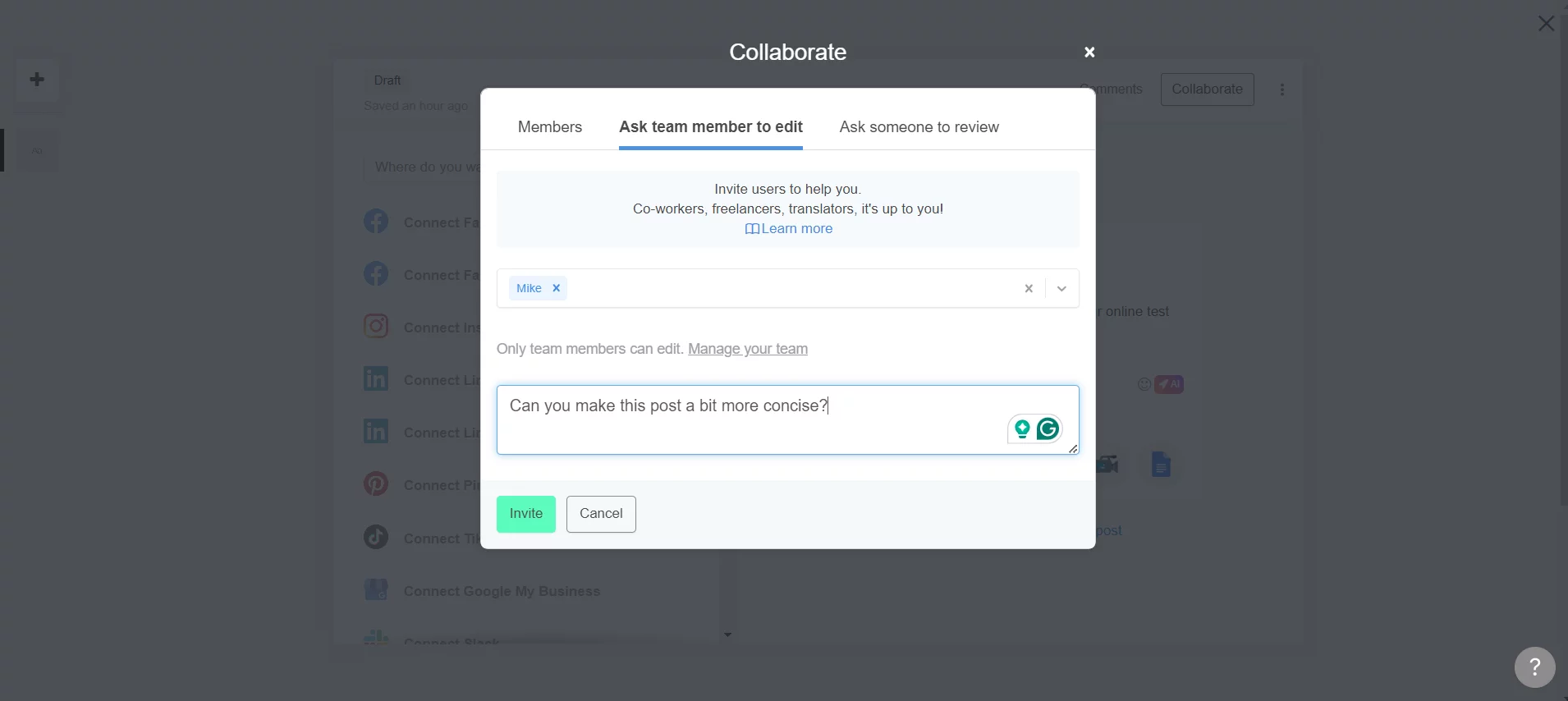

But again, StoryChief lacks any real-time collaboration capabilities, which can lead to unnecessary back-and-forths between content creators and reviewers.
Approvals
StoryChief’s approvals are straightforward — you can have multiple approvers for your content. They can either approve or reject the content, as well as leave feedback. As long as approvers have the publisher role assigned, they can post content even if the other team members haven’t approved the content yet.
Pricing: StoryChief includes two products — the Social Media Calendar and the Content Marketing Suite. Each has its own separate pricing package.
The Social Media Calendar starts at $40 per month (billed quarterly), while the Content Marketing Suite starts at $80 per month (billed quarterly). There’s also a 7-day free trial for both of the products’ entry-level plans.
You may be looking into StoryChief alternatives for:
- Convenience: The platform lacks features like real-time collaboration or seamless content re-scheduling.
- Analytics: StoryChief’s analytics are rather surfer-level. They don’t allow you to track network-specific metrics.
- Scalability: There are significant pricing differences between packages, which makes scalability an issue.
1. Planable – best for collaboration and approvals
Planable is a content scheduling and collaboration platform with a Universal Content feature that handles any type of written content — from social media posts to email, newsletter copy, blogs, and much more.
After testing both platforms, I found that Planable offers a more polished and complete feature set than StoryChief, with better collaboration features for more efficient content planning.


Collaboration, approval, and schedule features in Planable
For one, rescheduling content on Planable is just a matter of dragging and dropping a post onto the calendar — no need to browse through numerous menus and sub-menus. Its approval functionalities are also more structured and in-depth.
And there’s even more to it. So let’s go through a brief rundown of Planable’s key features.
Planning
Planable’s planning capabilities strike a perfect balance between functionality and ease of use. You can plan content by simply dragging and dropping it onto the calendar.


Content planning calendar in Planable
The platform lets you schedule the same post across multiple social media networks simultaneously through its SYNC ON/OFF tool. You can turn off the feature to make adjustments specific to each platform.
Planable also lets you organize scheduled content through color-coded labels, which is not possible with StoryChief. Other notable features include the option to easily edit an already-scheduled post, access to numerous views (Calendar, Grid, List, and Feed), and recurring post scheduling.
Collaboration
Collaboration is one of Planable’s hallmarks. Unlike other platforms, in Planable you can add Suggestions directly in the captions. You can also leave feedback next to each post through general comments or highlight and leave comments under specific fragments of text — ideal for long-form content like blog posts or video scripts.
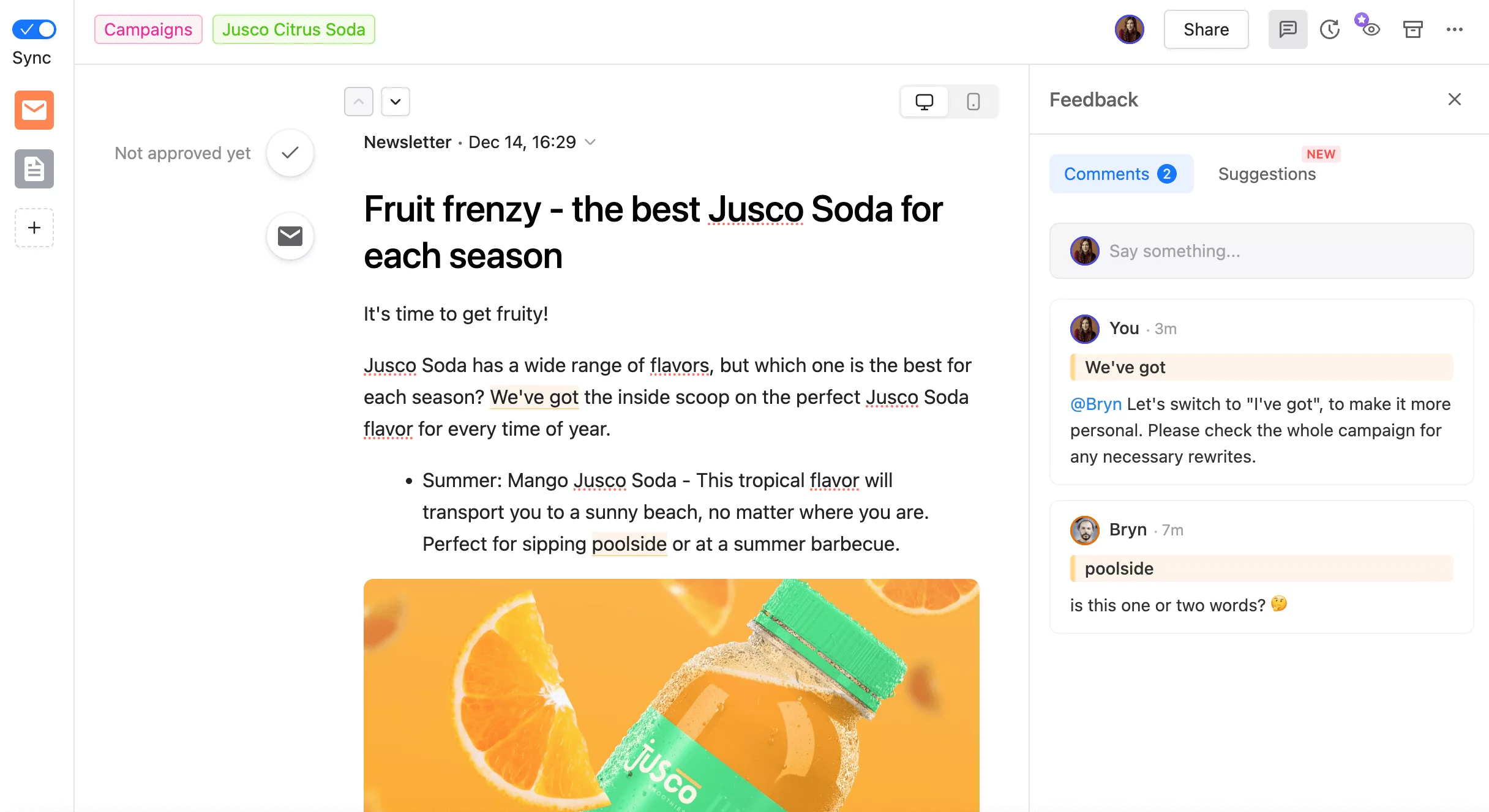

Collaboration with comments and suggestions in Planable for a newsletter
Planable also includes internal notes and posts, which are perfect for hiding away work-in-progress content from clients.
Other functionalities include the option to share content with external collaborators via shareable links, mark feedback as resolved, and add file attachments in comments, as well as get notifications.
Approvals
Planable’s approval workflows are highly customizable. You can pick between four workflow types: none, optional, required, and multi-level.
The platform’s multi-level approval workflows are the standout here — they ensure your post is reviewed and approved by multiple team members before publishing.
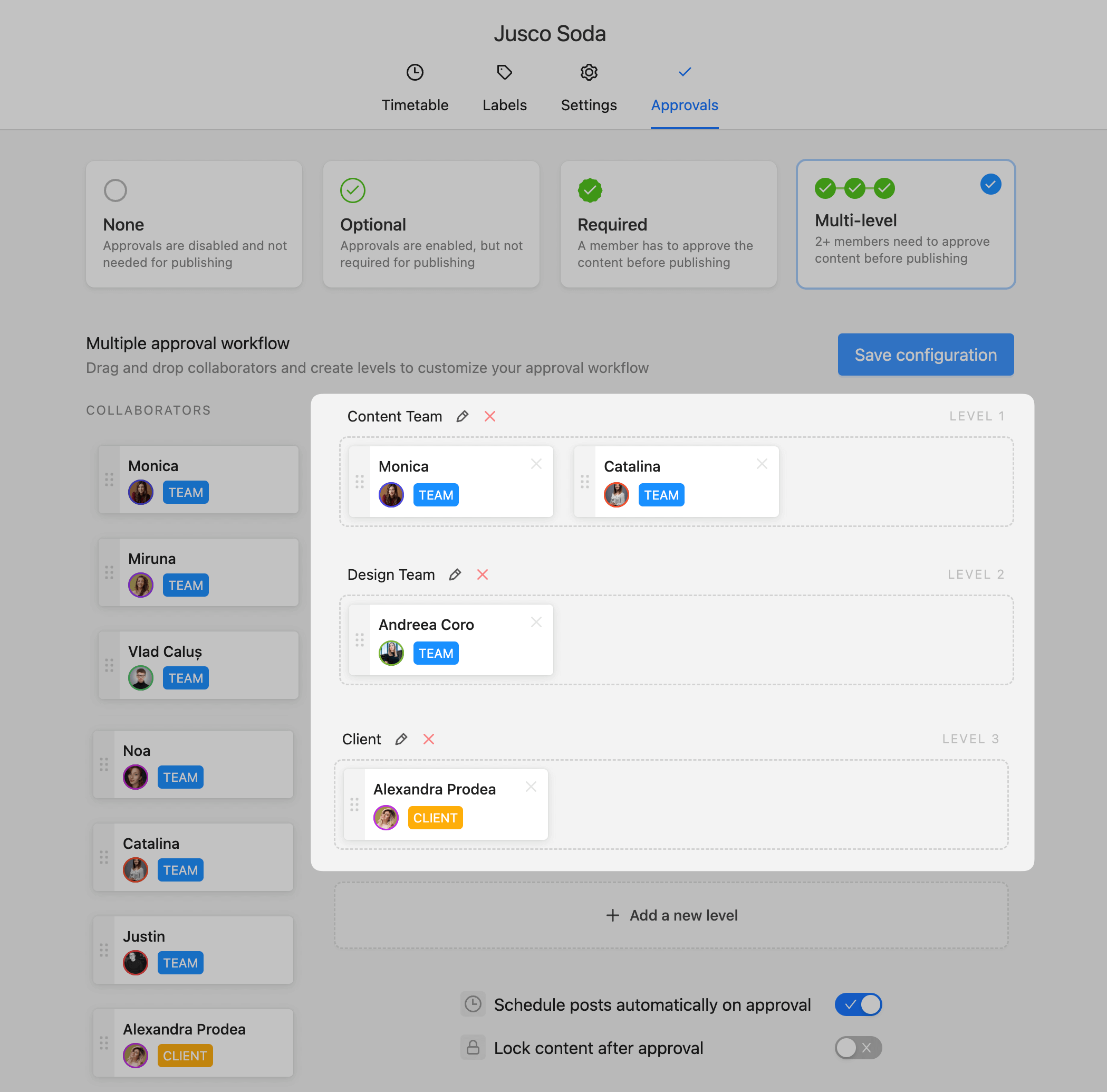

Multiple approval layers in Planable
A blog post can first be approved by the editor, followed by the content manager, while the client gives the green light, for instance. Planable can automatically schedule posts once they’re approved by all parties involved. Each approval level can have as many team members as you like.
You can also approve posts directly within the calendar with just one click.
Pricing: Planable starts at $11 per user per month (billed annually). Pricing is flexible based on how many users and workspaces you wish to include. There’s also a free version available that allows you to schedule up to 50 total posts and includes all Planable has to offer.
Drawbacks: Although Planable allows you to work and collaborate on any type of written content like blogs, there are no integrations with CMS platforms yet — you’ll have to copy/paste content from Planable to your CMS for publishing.
Planable vs StoryChief
- Ease of use: Both platforms are intuitive. But Planable brings numerous quality-of-life improvements, like easy content rescheduling and real-time collaboration capabilities.
- Features: Planable is more in-depth in terms of approvals, collaboration, and scheduling. However, StoryChief does offer native CMS integrations with WordPress or HubSpot, for instance.
- Scalability: Planable’s flexible pricing structure makes it the more scalable choice.
Takeaway: Planable is the best StoryChief alternative if you’re looking for a content collaboration platform with excellent scheduling and approval functionalities.
2. Bynder – best for digital asset management
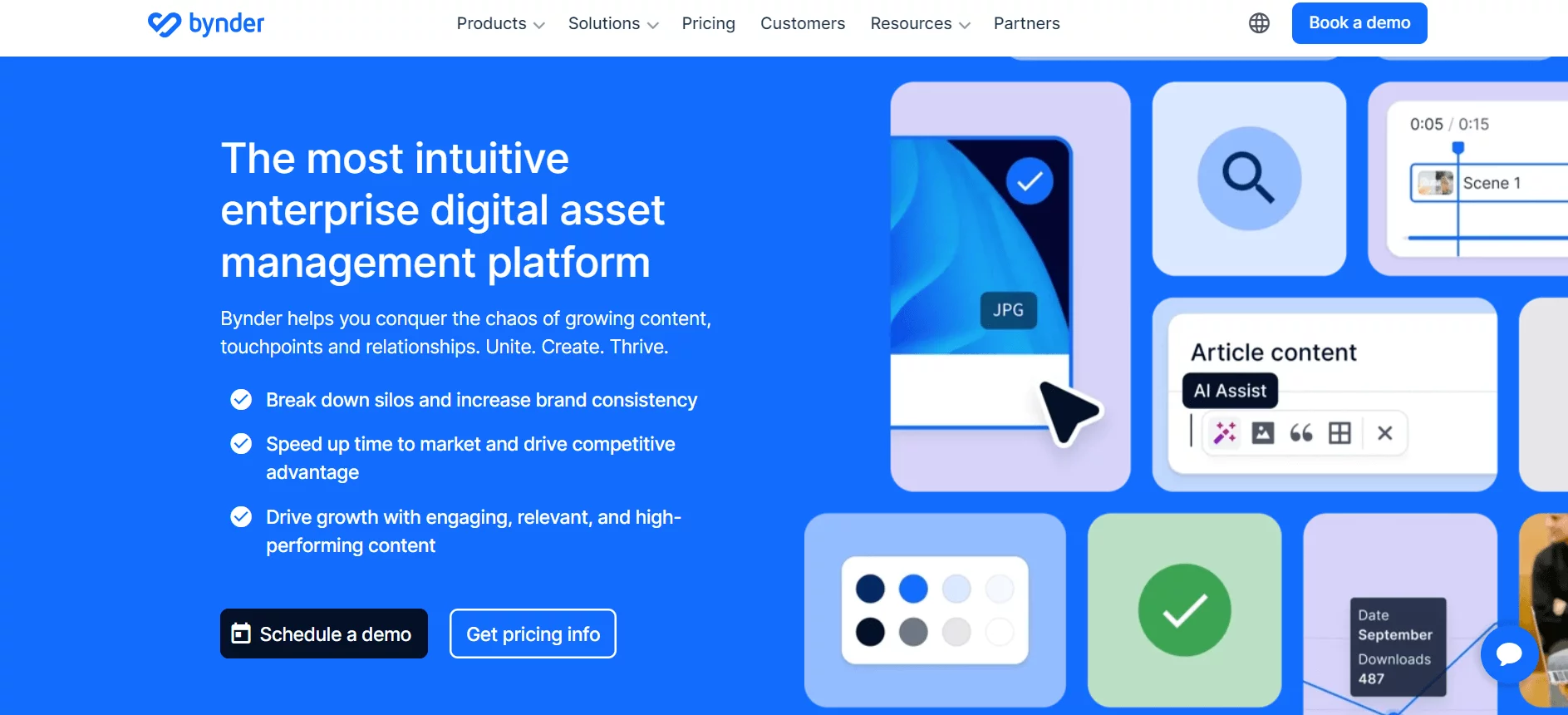

Bynder is a digital asset management platform that allows you to store and handle images, videos, logos, and other documents from a centralized dashboard.
The platform stands out through its automatic asset optimization capabilities — it can generate metadata for SEO visibility and automatically resize image files for faster loading speeds. Bynder also allows you to create and collaborate on written content, like blogs.
Key features
- Content Workflow: Create, approve, and collaborate on content in real time through Bynder’s Content Workflow tool (previously GatherContent). Leverage the platform’s AI capabilities to generate, edit, or translate texts.
- Studio: Easily import existing branded visuals from Sketch and Photoshop PSD to optimize them in Bynder, or create visuals from scratch directly within the platform. Turn existing designs into templates and duplicate them to streamline digital asset production.
- Brand guidelines: Create and store brand guidelines in the platform to ensure consistency. Easily share documents with clients or external collaborators.
Pricing: Pricing is upon request for all of Bynder’s pricing plans.
Drawbacks: No direct publishing tools available.
Bynder vs StoryChief
- Ease of use: StoryChief is easier to use. Bynder users generally report a steep learning curve.
- Features: StoryChief’s functionalities are geared toward content creation and publishing. Although Bynder also allows you to create written content, like blogs, the platform is best suited for branded digital assets.
- Scalability: StoryChief is better in terms of scalability. Most of Bynder’s digital asset creation tools are locked behind upper-tier pricing packages. The entry-level plan only allows for file storage, management, and distribution.
Takeaway: Bynder is among the solid StoryChief alternatives for businesses seeking to easily create, modify, and manage branded digital assets.
3. Allfred – best for advertising management
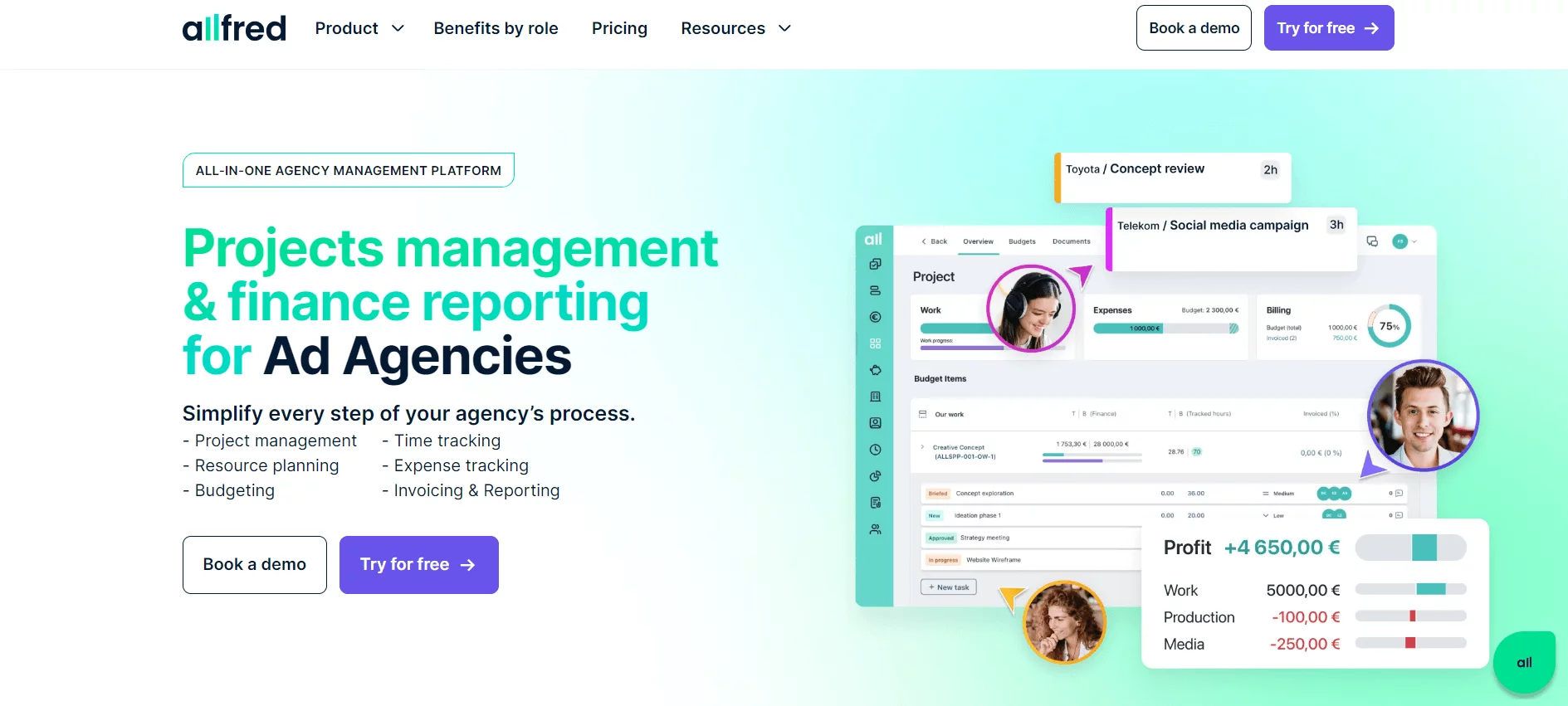

Allfred is a workflow management platform specifically designed for advertising agencies. It aims to simplify all business processes — from resource planning to budgeting, invoicing, and more. Allfred also offers a built-in CRM so you can easily track and manage clients or contractors.
Allfred’s Team Burnout Prevention feature is one of the platform’s standouts. It monitors your delegated tasks to identify which team members are at risk of overloading to help prevent assigning too much work to specific members.
Key features
- Task management: Assing tasks to team members. Set up deadlines, priorities, and task dependencies to keep work organized. Track and manage all of your project’s tasks from a centralized dashboard.
- Reports and analytics: Track revenue as well as team, project, and client profitability performance. Generate project reports and see how productive your teams were on specific projects through the platform’s time reports.
- Budgeting: Easily create budget plans via the platform’s pre-built budget templates. Get notified whenever a project exceeds your allocated budget, apply commissions and discounts, etc.
Pricing: Pricing for the platform’s all-in-one solution starts at $12 per user per month (billed annually). You can also use Allfred’s budgeting or resource planning and time tracking tools independently for $8 per user per month (billed annually).
Drawbacks: No built-in content scheduling tools are available.
Allfred vs StoryChief
- Ease of use: Storychief is more straightforward. Allfred is rather complex due to its broad set of features.
- Features: Allfred gears toward project management and budgeting, while StoryChief emphasizes content distribution.
- Scalability: Allfred is the more scalable option — it allows you to use specific tools independently.
Takeaway: Overall, Allfred is an excellent StoryChief alternative for advertising agencies seeking a solid project management tool complete with budgeting and resource management capabilities.
4. CoSchedule – best for content planning
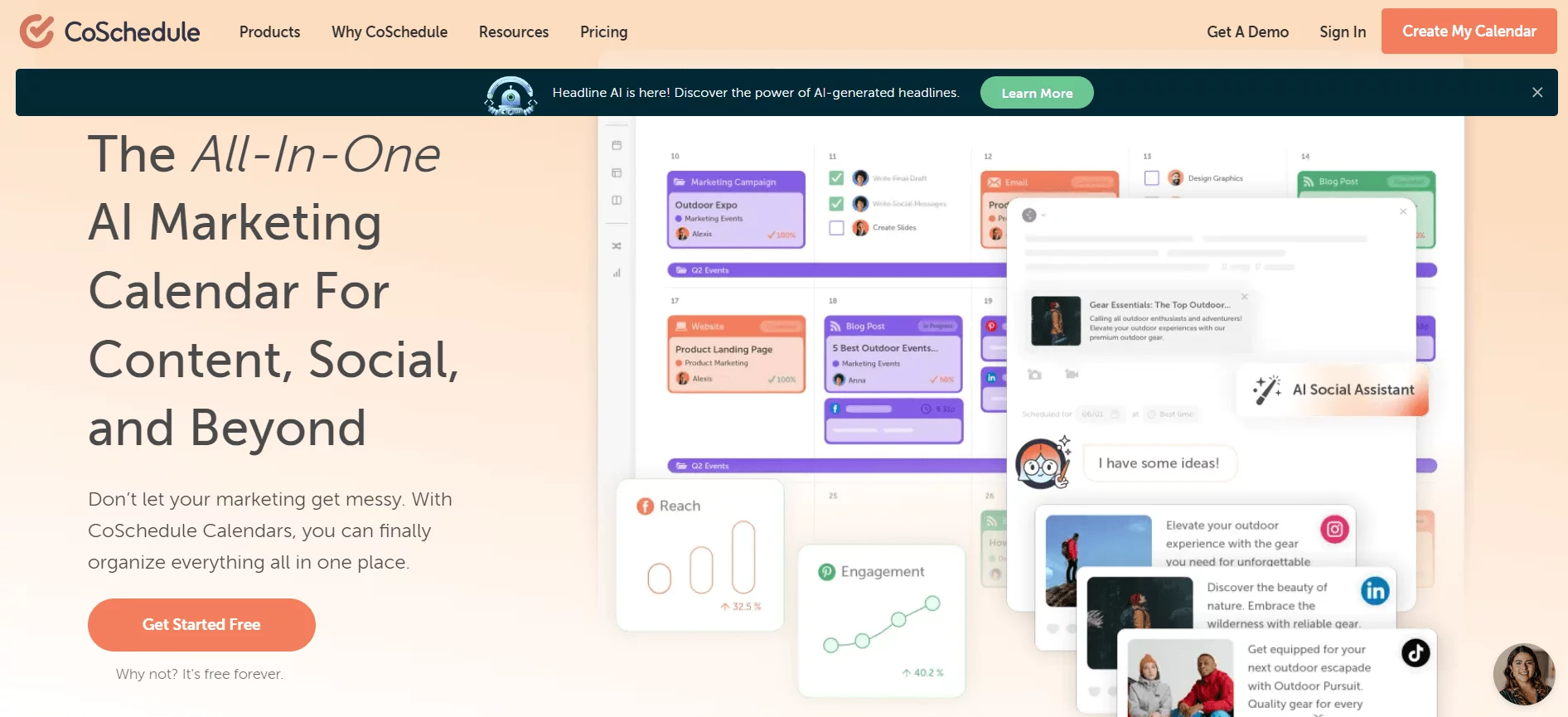

CoSchedule provides a centralized platform for content planning and marketing that stands out through its versatility. It blends a content calendar with project management functionalities, social media management, content ideation tools, and an AI-powered writing assistant.
The platform supports popular social media networks, like Facebook, Instagram, Twitter, LinkedIn, YouTube Shorts, TikTok, and Pinterest. It also integrates with Google Business Profile, Mastodon, and Bluesky.
Key features
- Calendars: Plan and schedule content via a drag-and-drop interface. Organize your work through color-coded labels and tags. Set up separate content calendars dedicated to specific channels, like social media, blog posts, or emails.
- Social media management: Use the platform’s Social Message Optimizer and ideal posting time suggestions to maximize engagement. Streamline your social media campaigns through the platform’s pre-built templates.
- Project management: Set up marketing projects from scratch or use CoSchedule’s project templates. Delegate tasks to team members and streamline your workflows through task automation, team collaboration tools, and customizable Kanban dashboards.
Pricing: CoSchedule includes a free version available for one user and two social media profiles. The platform’s paid plans start at $19 per user per month (billed annually).
Drawbacks: The platform’s approval workflows are locked behind its top-tier plan. The free plan also lacks Twitter publishing.
CoSchedule vs StoryChief
- Ease of use: Both platforms are easy to use, but CoSchedule’s ability to reschedule content via a drag-and-drop interface makes the platform more convenient in this regard.
- Features: CoSchedule’s project management features make the platform more versatile than StoryChief. It also includes an email subject line tester and an AI content ideation tool — unavailable in StoryChief.
- Scalability: Although CoSchedule offers a free version, its per-user pricing model makes it a less scalable option.
Takeaway: CoSchedule is an excellent option for a small business on the lookout for a platform that allows for easy content planning across numerous networks.
5. Asana – best for creative project management
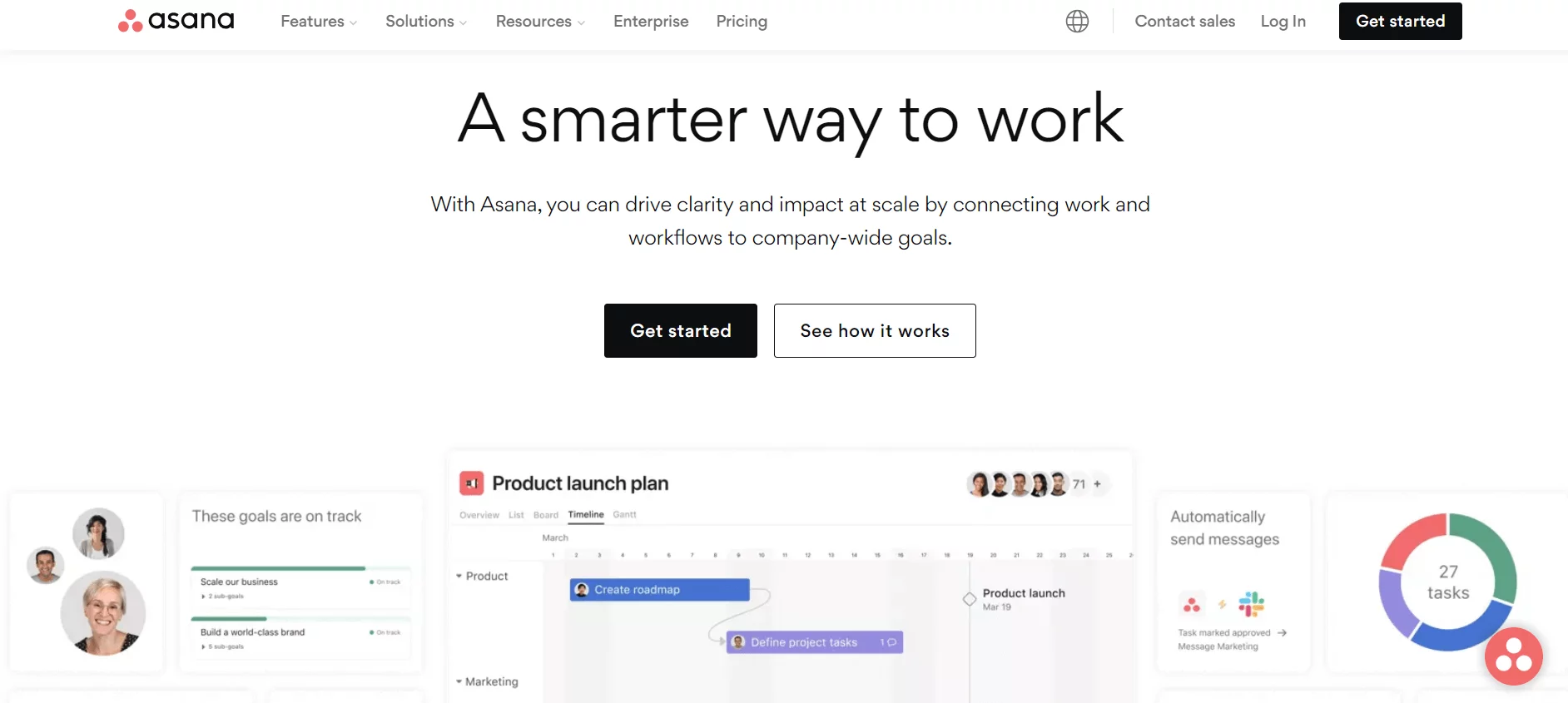

Asana is a comprehensive project management platform complete with team collaboration and file-proofing capabilities. The platform stands out through its solid free plan — it allows for up to ten team members and includes all the necessities like unlimited tasks, projects, comments, and various views (like list, board, and calendar views).
Key features
- Templates: Access numerous marketing-specific project templates, like social media and email marketing calendars, feedback workflows, or marketing campaign plans.
- Proofing: Allow stakeholders to leave feedback on images or PDF files. Automatically turn comments into tasks so team members can get to work right away.
- Project management: Use the platform’s Workflow Builder to create fully automated workflows via a drag-and-drop interface. Set up task dependencies, project goals, deadlines, and track status updates.
Pricing: There’s a free plan available. Paid plans start at $10.99 per user per month (billed annually).
Drawbacks: Asana lacks native time-tracking features.
Asana vs StoryChief
- Ease of use: Asana’s broad set of functionalities can make it harder to get used to the platform.
- Features: The platforms fulfill different purposes. StoryChief allows you to plan and publish content directly from the platform, while Asana is suitable for handling marketing campaigns from a project management perspective.
- Scalability: StoryChief is more scalable. Asana’s per-user pricing model, coupled with the large pricing differences between paid plans can make the platform get expensive quickly.
Takeaway: Overall, Asana is a great choice for a small business seeking a solid free project management tool.
6. ContentStudio – best for omnichannel content marketing
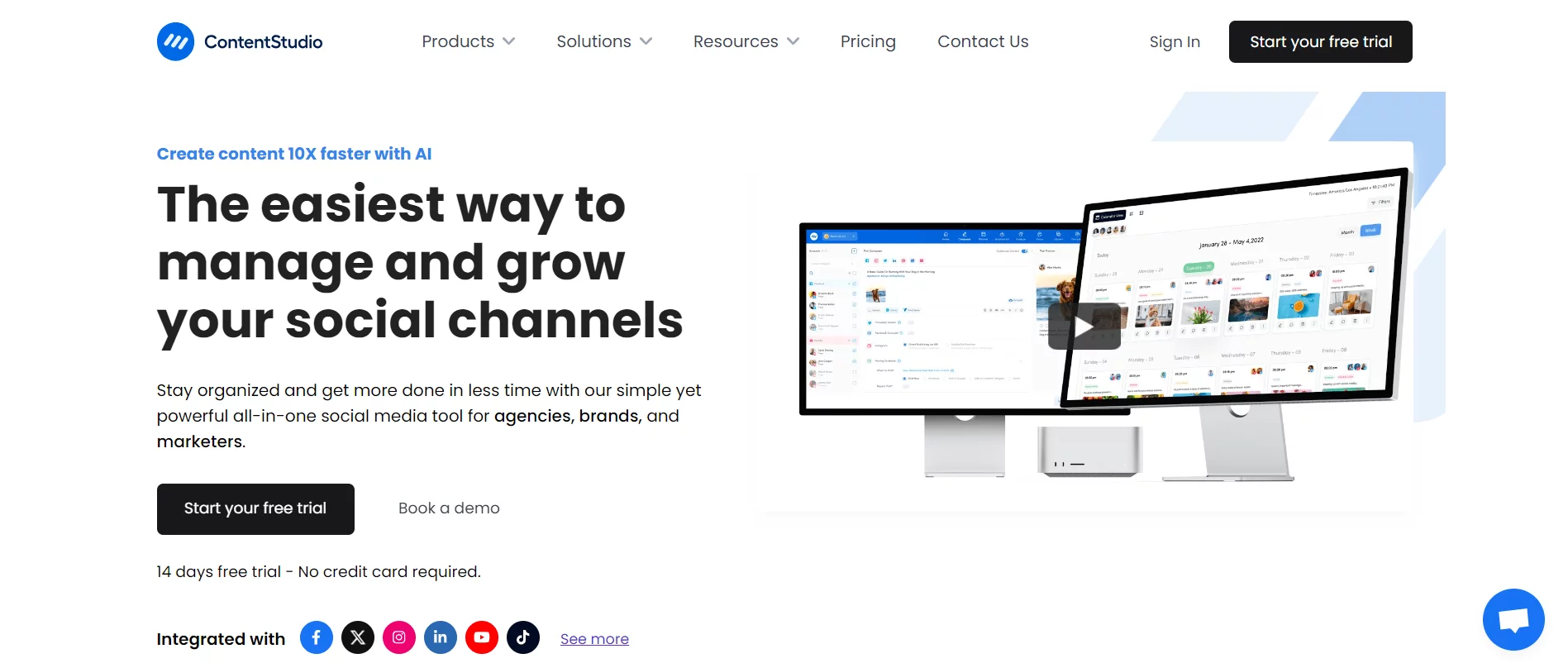

ContentStudio is an all-in-one social media management platform that allows you to publish, analyze, manage, and curate content across numerous social media networks — be it Instagram, Facebook, TikTok, LinkedIn, etc. It also covers team collaboration and multi-level approvals.
The platform also allows you to publish blogs to WordPress, Shopify, Medium, and Webflow websites in upper-tier pricing packages, making it ideal for omnichannel content marketing.
Key features
- AI features: Use the platform’s AI-powered capabilities to generate posts, social media captions, and images from scratch.
- Social inbox management: Monitor and reply to incoming messages from all social networks within a single dashboard. Leave notes and assign messages to the appropriate teammates.
- Analytics: Track competitors and demographics. Gauge performance across all social networks within a single dashboard or generate separate reports for each network to zoom in on the details.
Pricing: ContentStudio starts at $20 per month (billed annually) with a 14-day free trial available.
Drawbacks: Users often report a rather clunky UI.
ContentStudio vs StoryChief
- Ease of use: StoryChief is not as complex, making it easier to use. ContentStudio has more going on to it and feels less organized.
- Features: Unlike StoryChief, ContentStudio also offers content curation, inbox management, and influencer discovery tools.
- Scalability: ContenStudio’s pricing packages are more affordable across the board — favoring scalability.
Takeaway: ContentStudio is a solid choice for companies seeking to streamline their content marketing efforts across both social networks and websites.
Wrap-up: choosing the right StoryChief alternative for your content strategy
Overall, effective content marketing requires a lot of teamwork and a structured workflow to make sure your content rolls out error-free.
That’s why you should definitely give Planable a shot. Its comprehensive set of features, seamless collaboration capabilities, and multi-level workflows provide everything you need to streamline your content creation and marketing efforts.
Ready to try it out? Get started with the free 50 first posts!

